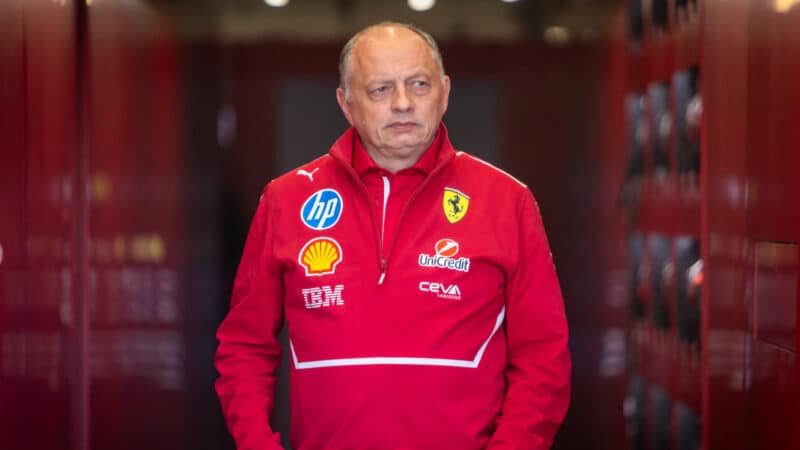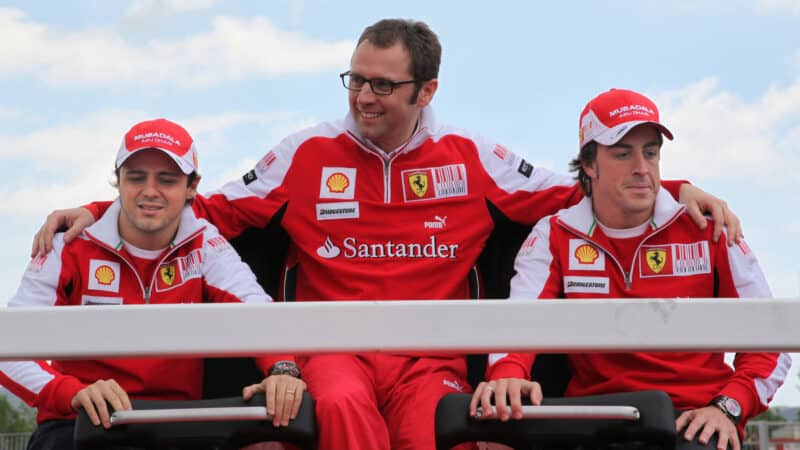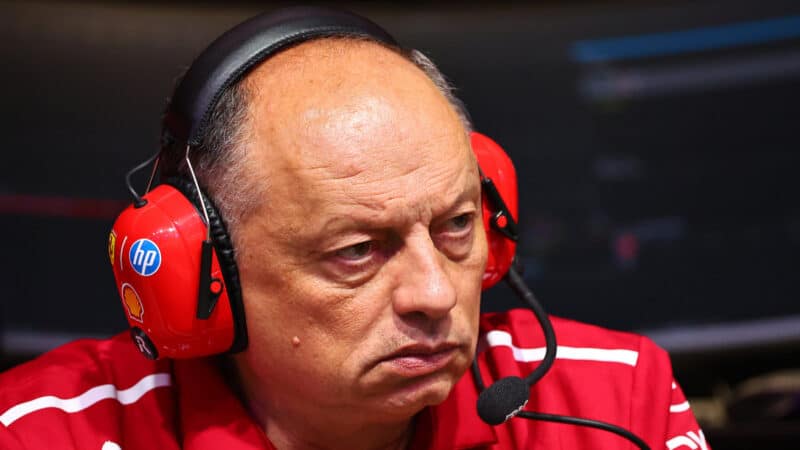The turbulent recent history of Ferrari's F1 team principals
Amidst relentless pressure from fans, media, and Ferrari's own upper management, the Scuderia has cycled through a series of team principals in recent years, each facing intense scrutiny

Vasseur is the latest Ferrari boss under pressure
Grand Prix Photo
Rumours about the future of Ferrari team principal Frederic Vasseur are now part of what’s become a rather normal cycle in the Scuderia’s recent and not-so-recent history.
The role of Ferrari team boss is arguably the most pressure-filled in all of motor sport, with a legacy of rapid turnover, internal politics, and intense media and fan scrutiny being an integral part of the job.
Since Jean Todt helmed the Maranello team from 1993 to 2007 as it enjoyed the most successful and dominant period by any team in F1 history, Ferrari team principals have come and gone at an alarmingly quick rate.
Five men have led Ferrari in the span of 17 years since Todt’s exit: Stefano Domenicali, Marco Mattiacci, Maurizio Arrivabene, Mattia Binotto and now Vasseur.
This is a look at the turbulent history of Ferrari’s recent team bosses.
Stefano Domenicali (2008-2014)
Todt’s successor Domenicali remains the most successful and the longest-standing of all the team bosses who came after former FIA president Todt.

Domenicali had the most success after Todt
Grand Prix Photo
Domenicali was a long-time Ferrari employee before he was promoted to the team principal role, having joined the Scuderia in the early 1990s and holding several jobs, including sporting director under Todt in 2002.
Domenicali took over his predecessor in 2008, leading the team to what is until now its final constructors’ championship. The drivers’ title was lost in the season-ending Brazilian Grand Prix, where Felipe Massa was famously defeated at the last second by Lewis Hamilton in the McLaren.
Ferrari continued to enjoy varied forms of success under Domenicali over the following years.
After a rather disappointing 2009, Ferrari came agonisingly close to the drivers’ title with Fernando Alonso, who lost out to Red Bull‘s Sebastian Vettel by four and three points respectively, both times in the final races of the season.
While Alonso fought for the title in 2012, it was the Spaniard’s driving that made up for his car’s weakness as Ferrari’s form started to decline under Domenicali.
Vettel dominated the 2013 season, the final year before a major rules overhaul with the introduction of V6 turbo-hybrid engines in 2014.
Under Domenicali’s leadership, Ferrari failed to capitalise on its resources and manpower despite the rules reset, struggling with an uncompetitive engine that left the team fighting in the midfield.
Under mounting pressure, Domenicali resigned in April 2014.
After Ferrari, Domenicali moved on to senior roles at Audi, Lamborghini, and eventually became Formula 1’s CEO, a role that he still holds.
Marco Mattiacci (2014)
After Domenicali’s exit, Ferrari turned to Marco Mattiacci for the role of team principal.

Mattiacci arrived in F1 without previous experience
Grand Prix Photo
The decision was surprising given that Mattiacci had no previous Formula 1 experience: his background was in Ferrari’s road car business, notably as president and CEO of Ferrari North America.
Under Mattiacci, Ferrari endured its worst season in over two decades, finishing fourth in the constructors’ championship and failing to win a race for the first time since 1993.
His appointment coincided with a period of major upheaval at Ferrari, as long-time team president Luca di Montezemolo was ousted and replaced by Sergio Marchionne, who quickly moved to install his own leadership.
Mattiacci, who many saw as an interim figure, contributed to instability and uncertainty within the team due to his lack of experience. It was during his spell, that Ferrari lost its star driver Alonso to McLaren, although the Italian managed to secure the services of Vettel to replace the Spaniard.
Mattiacci lasted seven months in the role before he was replaced at the end of the 2014 season.
Maurizio Arrivabene (2015–2018)
Arrivabene was a Marchionne hire, replacing Mattiacci late in 2014 in an attempt to bring stability and rejuvenate the Scuderia after a disastrous season.

Arrivabene’s style made him no friends
Grand Prix Photo
Arrivabene came from a marketing and sponsorship background, having worked for Philip Morris for 27 years. He also managed the Marlboro-Ferrari partnership.
Under his leadership, Ferrari returned to winning ways in 2015, with Vettel taking three victories on his way to a distant third behind the Mercedes drivers in the championship.
The Maranello team also doubled its points from the previous year and looked set for a title fight in 2016.
But that didn’t happen. Instead, Ferrari dropped to third in the standings and failed to win a single race.
But Arrivabene led another resurgence the following two years, in which Ferrari and Vettel were in contention for the championship into the latter stages of the season.
However, mistakes — both operational and strategic — combined with Mercedes’ superior development, saw Ferrari’s challenge collapse after the summer breaks.
Arrivabene’s culture of fear at the Scuderia – and with the media – meant he made few friends during his stint, which came to an end after 2018, when Marchionne was convinced Ferrari needed a less intimidating approach to returning to the top…
Mattia Binotto (2019-2022)
… And that’s how Binotto, a much more gentle manager, became team principal at the start of 2019 with the goal of reuniting a divided outfit.

Binotto will lead Audi now
Grand Prix Photo
Like Domenicali, Binotto had been with Ferrari for decades before he moved into the role, having played a key role in the technical department during the dominant Todt/Schumacher era.
Under Binotto, Ferrari enjoyed a promising 2019 season, finishing second in the standings and winning three races.
That year, however, was marked by controversy as Ferrari was accused of using illegal engine tricks. Although the FIA was unable to prove the engine was illegal, the Scuderia had to agree to a confidential settlement with the ruling body, and its performance dropped sharply the following year.
2020 proved to be a disaster for Ferrari, which dropped to sixth in the standings, its worth result in four years.
The car proved very uncompetitive, especially in terms of straight-line speed, widely attributed to changes in FIA technical directives targeting its engine.
The pressure was on Binotto to help Ferrari recover, and 2021 proved a more successful year, although it was still far from the frontrunners and didn’t win a race.
A strong start to 2022 gave Ferrari hope that it could finally fight for the title again, but once more its challenge diluted as a result of reliability failures and strategic errors.
By the end of the season, Italian media started to report on speculation about Binotto’s future, naming Vasseur as a possible replacement.
At the time, Ferrari sent a statement saying the rumours were “totally without foundation”. Binotto resigned a week later.
Frederic Vasseur (2023-present)
Vasseur was appointed as Binotto’s replacement about two weeks after the Italian’s exit, becoming the first non-Italian Ferrari team principal since Todt.

Vasseur convinced Hamilton to join Ferrari
Grand Prix Photo
Like with others before him, Vasseur’s spell has been a mixed bag for Ferrari, with both success and frustration almost on equal amounts.
His first season in 2023 saw Ferrari drop from second to third in the standings as Red Bull dominated the year. Despite being singled out as favourite during pre-season testing, the Scuderia only won one race that year.
The 2024 campaign marked a significant turnaround for Ferrari, which won five races and scored 22 podiums. It stayed in the championship battle for a long time, but ultimately ended up falling behind rival McLaren.
Although Ferrari is second in the standings in 2025, the season has not been what the team expected, as its far from frontrunner McLaren and often behind the Red Bull of Max Verstappen and the Mercedes.
Vasseur’s biggest coup since his arrival was convincing Lewis Hamilton to join Ferrari for 2025, but the seven-time champion has struggled to adapt and be competitive.
This year’s problems have Vasseur under increasing scrutiny from Italian media and fans even before the halfway point of the season. Some names have already been mentioned as possible replacements.
The speculation about Vasseur’s future has been denied by Hamilton, but denials have always been part of the process and only time will tell where Vasseur’s future lies.
